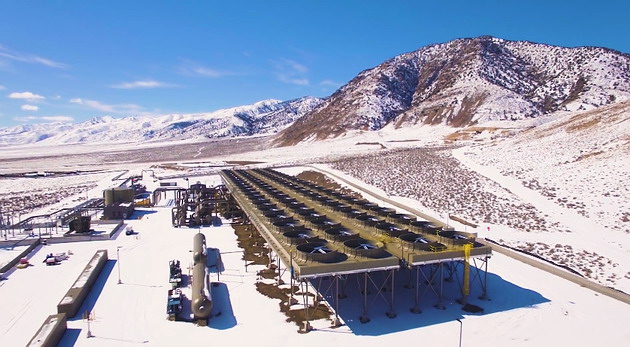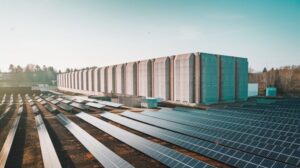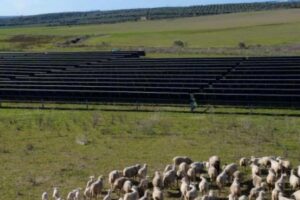Geothermal Energy Definition

To define geothermal energy, we first need to explain why the core of our planet is a renewable resource of natural heat and clean power for us.
The surface of the Sun has a temperature around 5,800 K (10,000 F), while the inner core of our planet has an average temperature of 6,250 K (10,800 F).
The outer core of the planet is also very hot (less hotter than the surface of the Sun), with an average temperature of about 4,450 K (8,000 F).
The mantle is less hotter than the core of the planet, but is hot enough (an average temperature of 2,600 K, or 4,200 F) to be a source of renewable energy for us.
Geothermal Energy Definition
Geothermal energy is a renewable resource generated by the underground heat produced in the inner core of our planet. This natural heat reaches the surface of the planet under the form of warm water and steam, which can be used for residential heating and cooling and also to generate clean electricity.
This natural resource provided by our planet for free is used today for residential heating and cooling and in power plants to generate clean electricity.
Countries such as El Salvador, Kenya, the Philippines, New Zealand, Iceland and Costa Rica have great resources of geothermal power, which counts for about 15% in their energy mix.
Geothermal Energy Used for Residential Heating and Cooling
Geothermal energy (thermal energy) is suited for residential heating and cooling in Northeast U.S. and in many other areas of the planet where the underground resource of natural heat is close to the surface.
There are two types of geothermal heat pumps (ground source heat pumps):
How Does A Geothermal Heat Pump Work?
Both heat pumps (horizontal and vertical) work essentially the same, the difference is made by the way they access the underground heat.
The underground heat provided by the Earth’s core can be used for heating air or water.
In the air type systems, the heat pump can also have a reversing valve to supply either heating or cooling.
In both cases, the outdoor heat exchanger can be a plate heat exchanger with the refrigerant passing on one side, and a mixture of water and antifreeze cycling on the other side.
The water and the antifreeze mixture is forced by a pump around the pipes within the ground to pick up the thermal energy in a heating mode and bring it to the heat exchanger.
The refrigerant on the other side of the heat exchanger absorbs the heat because it has a very low boiling point, so as it boils, it carries the heat away, which can then be used within the building for heating.
The air type system can use a reversing valve to allow the refrigeration system to pull the unwanted heat out of the building and transfer it into the water and antifreeze mixture.
This water will then be pumped around pipes in the ground to transfer the heat there.
The returning cooler will be ready to pick up more heat and restart the process.
How Does A Geothermal Power Plant Work?
Geothermal power plants use superheated fluids from the Earth’s geothermal resource (thermal energy) to generate clean electricity.
The natural heat of the Earth’s core creates the geothermal resource. The heat is produced by the molten rock called magma, which is located deep below the geothermal resource.
The underground reservoirs of water that are heated by the magma, have been created over a period of thousands of years due to the fact that rainwater seeped through cracks in the planet’s surface.
The very hot magma heats these underground reservoirs of water until they become superheated fluid.
To reach the underground reservoirs of water where the superheated fluid is located, wells are drilled 5,000 to 10,000 feet below the surface of the planet.
These wells are called production wells because they bring the superheated fluid to the surface where it can be used to generate clean electricity for homes and businesses.
The superheated fluid will be turned into steam to drive a turbine and generate electricity.
Geothermal energy is a renewable resource
The remaining geothermal fluids will be injected back into the reservoir for reuse.
Due to its own pressure, superheated fluid from the geothermal resource flows naturally through the production wells, and while flowing to the surface, the pressure of the superheated fluid decreases causing a small volume of superheated fluid to separate or turn into steam (the term used in the sector is “flash” into steam).
When reaching the surface, the superheated fluid and the mixture of steam flows through surface pipelines and into a wellhead separator.
Inside the separator, the pressure of the superheated fluid is reduced, which causes a large amount of superheated fluid to vaporize and flash into high-pressure steam.
The superheated fluid that is not flashed in the separator, flows to a second vessel called standard-pressure crystallizer to produce an additional amount of pressure steam.
The flash process will continue in the low-pressure crystallizer to flash the remaining superheated fluid and produce low-pressure steam.
Geothermal Power Plants Are Very Efficient
The fluid that is not flashed will flow through the reactor clarifier system and will be sent back to the geothermal reservoir through injection wells.
The large steam turbines used by the geothermal power plant start to spin under the force and energy of the steam.
The spinning blades of a turbine will rotate a shaft connected to the generator and will produce clean electricity.
Large copper bars are used to transfer the electrical charge produced by the generator to a step-up transformer outside the plant.
The transformer is used to increase the voltage before the electricity is sent to the power lines.
From the power lines, the clean electricity produced by the geothermal power plant will be used to power homes and businesses.
Geothermal energy is a renewable resource and also a sustainable source of energy because with proper management, a geothermal resource can be turned into a long term source of clean electricity.
A geothermal reservoir is depleted after a long period of time
Water trapped deep within the Earth’s crust, will naturally replace the superheated fluid used by the geothermal power plant.
The geothermal resource can be depleted only if the superheated fluid is removed faster than it can be naturally replaced.
To prevent this, the steam used by a geothermal power plant will pass through a condenser, which turns it back into fluid state.
During this process, minerals can be recovered from the geothermal fluid before is injected back into the underground reservoir.
The condensed fluid along with the superheated fluid that was not flashed into steam are sent back in the underground reservoir through the injection wells.
Magma will naturally reheat the fluid, and this way, the geothermal power plant will be able to generate clean electricity using the geothermal reservoir for a very long time.
Conclusion
Geothermal energy is a great source of renewable and sustainable electricity that can be used to replace the dirty fossil fuels especially in areas where the underground reservoirs of thermal energy are available.







